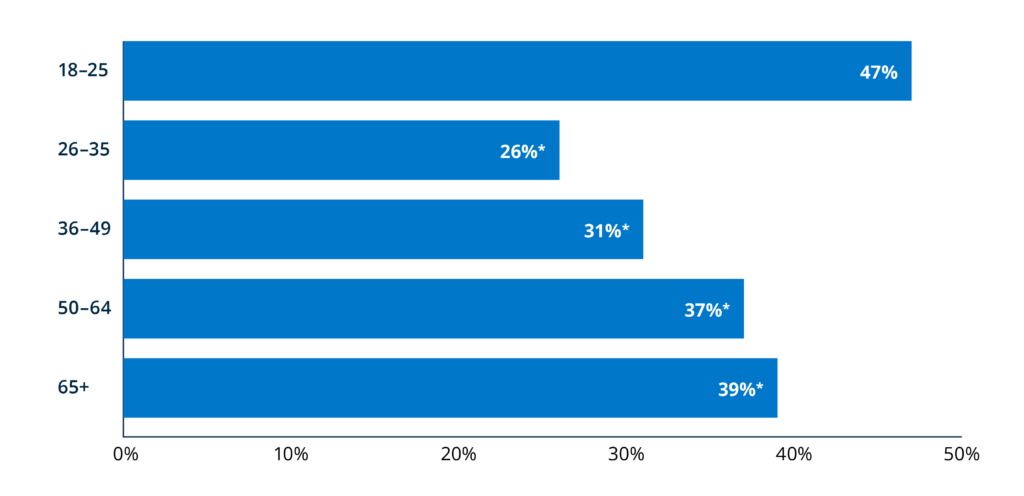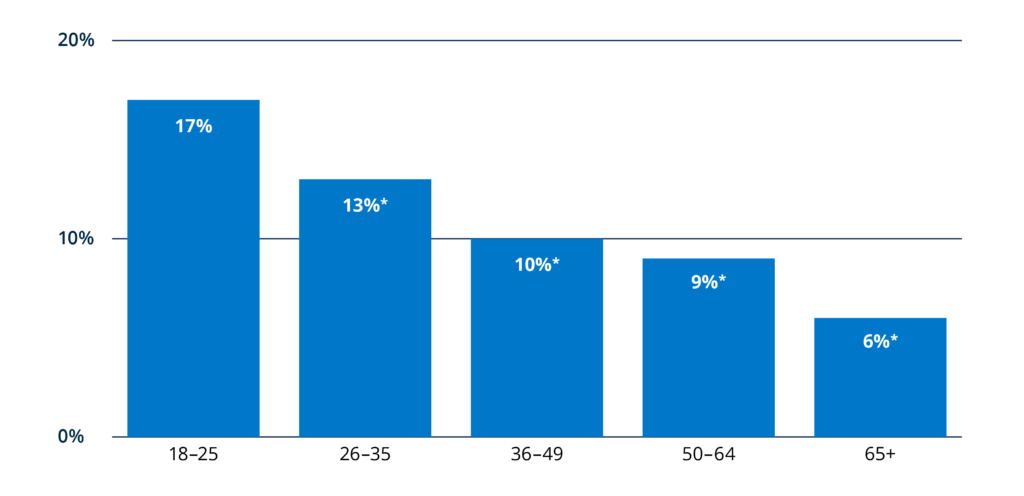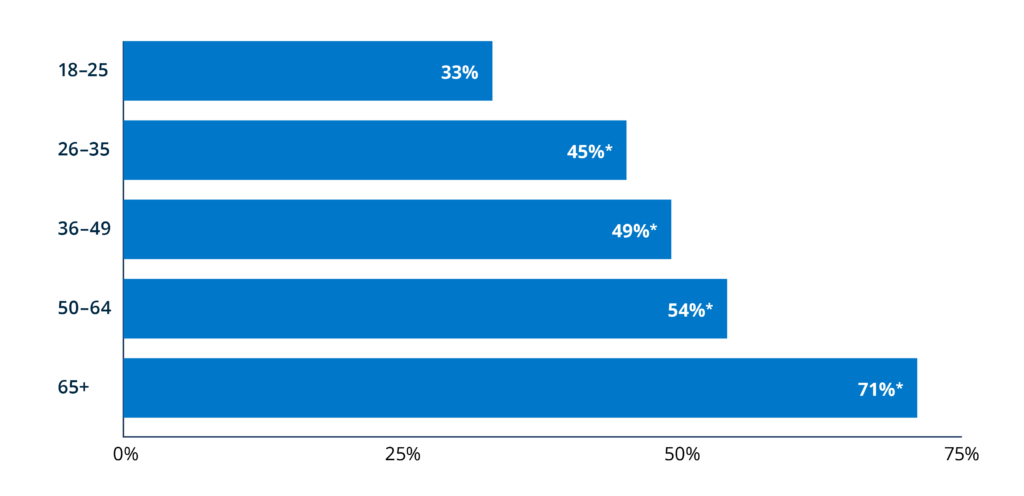Strategies To Encourage Credit Score Monitoring Among Young People
A significant portion of young adults don’t regularly check their credit scores, but financial institutions can help turn this trend around.
By Wanjira Chege, Kennan Cepa, Ph.D., Angela Fontes, Ph.D.
-
Program:
-
Category:

Used across the financial and housing industries, a credit score is a major factor considered when determining access to financial resources and housing.1 Thus, it is critical that people have access to their credit score so they can be informed about their financial standing. Credit score monitoring can also alert people to any change in their credit score, which may indicate unauthorized or fraudulent activities or errors reported by businesses to credit reporting agencies.2, 3
Some may prefer to check their credit scores, instead of their full credit report, to get a quick sense of whether their credit standing has changed and to understand how users of the report perceive their creditworthiness. Many financial institutions provide credit scores to their customers through online banking platforms or monthly statements. Others rely on companies that offer credit marketing services, which advertise access to credit scores for customers.4
Despite efforts to improve access to credit records and encourage regular credit monitoring, there is limited information about how common it is for people living in the U.S. to check their credit scores and who is actively engaging in this practice. This information is critical for financial institutions and policymakers to understand potential barriers to credit management, which in turn helps them tailor products and outreach efforts to specific populations.
Recent Efforts To Improve Credit Report Access
Credit scores are calculated based on the information collected in credit reports, which the Consumer Financial Protection Bureau (CFPB) recommends checking as frequently as every 12 months.5, 6 In 2003, the Fair and Accurate Credit Transactions Act was signed into law, making credit reports available to consumers for free on an annual basis.7 And in 2020, checking credit reports became even easier when the three nationwide credit reporting agencies created a program that allows Americans to check their credit reports at each of the agencies weekly for free.8
According to data collected from April through June of 2023 by the Financial Health Network as part of its Financial Health Pulse® study, a third (32%) of Americans did not check their credit score in the last year. Individuals who did not check their credit scores often included those with lower financial health, lower income, or lower education levels; people who self-reported having poor credit scores; renters; Latinx people; and young adults.
One of the largest gaps in credit checking practices occurred across age groups, with almost half (47%) of young people (18- to 25-year-olds) not checking their credit scores in the last 12 months – a considerably higher share than older age groups (Figure 1).
Figure 1. Almost half of young adults (ages 18 to 25) did not check their credit scores in the last year.
Percentage of people who did not check their credit scores in the last year, by age group.

Note: * statistically significant relative to 18- to 25-year-olds at p < 0.05. Data from 2023 Financial Health Pulse® survey. N = 8,269 respondents who responded to the question, “In the past 12 months, have you checked your credit score?.”
“It is concerning that many young people are not regularly monitoring their credit scores because it leaves them uninformed about their financial well-being and unprepared for potential future financial needs, such as buying a home or a car or even securing rental housing.”
Financial institutions can play a critical role in helping more young adults monitor their credit scores. By understanding why young adults may not be checking their scores, they can implement strategies that are geared toward engaging younger individuals more effectively. While the 2023 Financial Health Pulse study did not collect data on why a consumer may not be checking their scores, concepts from behavioral science may offer a number of explanations.
Strategy 1: Help Young People Build Credit by Including Alternative Data in Credit Reporting
Younger adults may not regularly check their credit scores because they have less engagement with credit products and services. Our data reveal that individuals living in households without auto loans, credit cards, mortgages, small business loans, or past-due medical bills, which are the main components of building credit scores, less frequently report checking their credit scores within the last 12 months. And young adults less frequently have these forms of debt compared with their older counterparts (Figure 2). This suggests that the absence of such debt is related to less frequent credit score monitoring among young adults, potentially because they may not have credit scores at all.9
Figure 2. Young adults less frequently have the forms of debt mainly used to calculate credit scores.
Percentage of people without various forms of debt, by age group.

Note: * statistically significant relative to 18- to 25-year-olds at p < 0.05. Data from 2023 Financial Health Pulse® Survey. N = 8,270 respondents who answered “no” to the following questions: “Do you or anyone in your household currently have one or more of the following types of credit cards? [1.General purpose credit card 2. Store credit card]”, “Do you or anyone in your household currently have any of the following types of debt? [1. Auto loans 2. Small business loans 3. Mortgages 4. Past-due medical bills].”
Financial institutions could help young adults establish a solid financial foundation for their future.
-
- Financial institutions and rental housing providers can more consistently report on-time utility and rent payments to credit bureaus.
- Credit bureaus can consistently incorporate information on on-time rental and utility payments and payment history into credit scores.
- Financial institutions can proactively offer lower-risk credit products, such as secure credit cards, to young people to help them build credit profiles.
Strategy 2: Make Credit Score Checking Relevant, Easy, and Fun
Another reason younger consumers check their scores less frequently could be that they don’t think credit scores are relevant to their current financial lives. Older generations often view financial milestones, such as homeownership, as a marker of financial success and adulthood, but young adults (aged 18 to 25) are increasingly embracing flexible living arrangements or delaying the attainment of financial milestones.10, 11, 12, 13
For instance, homeownership is a major financial decision often requiring a mortgage, and lenders use credit scores to make loan determinations. But without the immediate goal of qualifying for a mortgage, the importance of a credit score might not be as apparent or prioritized in a young adult’s financial planning, reducing the chances they monitor their scores regularly.
Financial institutions can offer tailored financial products and services that make credit score checking relevant, easy, and fun.
-
- Financial institutions can develop products or services that help young adults set and track progress toward longer-term financial goals that they find relevant, fostering a sense of progress and engagement on their financial journey.14
- Financial institutions can “gamify” credit checking by offering badges or the ability to “unlock” rewards when a consumer engages in positive checking behavior.15
- More financial institutions can build products that reduce the friction associated with regular credit checking by offering reminders and a link that a consumer could use to check their scores.16, 17, 18
- By developing partnerships with financial centers at colleges and universities, financial institutions can reach more young people and show that checking credit scores is relevant to their lives.
Strategy 3: Reduce the Anxiety Associated With Checking Credit Scores
Avoiding disappointing or unpleasant financial news is often cited as a factor influencing various financial behaviors.19 Indeed, young adults less frequently self-report having an excellent or very good credit score compared with their older counterparts (Figure 3), potentially deterring them from regularly checking their credit scores. However, not monitoring credit scores can exacerbate credit problems over time.20
Figure 3. Young people less frequently report excellent or very good credit scores.
Percentage of people with excellent or very good self-reported credit score, by age group.

Note: * statistically significant relative to 18- to 25-year-olds at p < 0.05. Data from 2023 Financial Health Pulse® survey. N = 8,269 respondents who responded to the question, “How would you rate your credit score? Your credit score is a number that tells lenders how risky or safe you are as a borrower.”
Financial institutions can help young people overcome risk avoidance around credit scores.
-
- For young people who have low credit scores because their credit history is relatively short, financial institutions can demystify credit scores and foster a sense of progress by projecting how a young person’s credit score may develop over time with future on-time payments and sharing that information alongside current credit scores.
- By offering tailored debt management support and lower-risk credit products to young people, especially those struggling with credit card debt, financial institutions can transform the credit monitoring experience from one of apprehension to one of empowerment and positive engagement.21, 22, 23
Financial institutions have an important role in helping young people with credit score monitoring. By proactively providing products and support tailored to the needs of young people, financial institutions and professionals not only empower the younger generation with essential financial skills, but also contribute to the overall health of the financial landscape.
“Credit score monitoring is an important part of overall financial health. And while behaviorally informed ‘nudges’ have been used to support a variety of positive financial behaviors, financial institutions have an opportunity to use some of these same approaches to support regular credit monitoring, particularly for young adults.”
Methodology
Data from this release come from the Financial Health Pulse survey. Financial Health Pulse surveys are fielded using the probability-based Understanding America Study online panel, allowing the findings to be generalized to the civilian, noninstitutionalized adult population of the United States. The 2023 Financial Health Pulse survey was fielded from April 27, 2023, through June 11, 2023, with 8,655 respondents and a cooperation rate of 69.38% (margin of error +/- 1.05%). For more background on the report’s methodology, visit the FinHealth Score® Methodology page.
- “What is a credit score?,” Consumer Financial Protection Bureau, last updated August 2023.
- “Why Should I Check my Credit Reports and Credit Scores?,” Equifax.
- True Tamplin, “What Is Credit Monitoring?,” Finance Strategists, last updated September 2023.
- “How Can I Check Credit Scores?,” Equifax.
- “Check your credit report at least once a year,” Consumer Financial Protection Bureau.
- Each credit scoring agency uses distinct methodologies and models to calculate credit scores, leading to variations in scores across agencies. See Bill Fay, “Credit Scoring Models,” Debt.org, last updated September 2023.
- “Public Law 108–159,” Government Publishing Office, GovInfo, December 2003.
- Colleen Tressler, “You now have permanent access to free weekly credit reports,” Federal Trade Commission, Federal Trade Commission Consumer Advice, October 2023.
- Kenneth P. Brevoort, Philipp Grimm, & Michelle Kambara, “Data Point: Credit Invisibles,” The CFPB Office of Research, May 2015.
- Kennan Cepa & Frank F. Furstenberg, “Reaching Adulthood: Persistent Beliefs about the Importance and Timing of Adult Milestones,” Journal of Family Issues, May 2020.
- Richard Fry, “Chapter 1: The Changing Financial Mileposts of Young Adults,” Pew Research Center, February 2013.
- Molly Barth, “Gen Zers are turning to ‘radical rest,’ delusional thinking, and self-indulgence as they struggle to cope with late-stage capitalism,” Fortune, June 2023.
- Frank Furstenberg & Sheela Kennedy, “growing up is harder to do.2: after the great recession,” Contexts, November 2016.
- Stephen Roll, Michal Grinstein-Weiss, Emily Gallagher, & Cynthia Cryder, “Can pre-commitment increase savings deposits? Evidence from a tax-time field experiment,” Journal of Economic Behavior & Organization, December 2020.
- Maulik Jain et al., “Application of Gamification in the Banking Sector: A Systematic Review,” TEST Engineering & Management, April 2020.
- Levison Chiwaula et al., “Combining Financial-Literacy Training and Text-Message Reminders to Influence Mobile-Money Use and Financial Behavior among Members of Village Savings and Loan Associations: Experimental Evidence from Malawi,” Partnership for Economic Policy Working Paper No. 2020-10, last updated August 2020.
- Heidi Johnson, Hannah Gdalman, & Zaan Pirani, “Behavioral Design Guide: A Financial Health Approach to Credit Card Products,” Financial Health Network, May 2023.
- Madelaine L’Esperance, “Nudging credit union members to check their credit: Evidence from a field experiment,” Journal of Behavioral and Experimental Finance, March 2023.
- Jessica Fong & Megan Hunter, “Can Facing the Truth Improve Outcomes? Effects of Information in Consumer Finance,” last updated January 2021.
- Natalia Shakhina, “Are You Making Bad Financial Decisions Because of Information Avoidance?,” The Decision Lab, October 2018.
- Martha C. White, “Gen Z Is Poised to Spend More on Debt Than Others. It Could Derail Retirement.,” The New York Times, September 2023.
- Jennifer Streaks, “As Gen Z grows up, its credit is lagging behind,” Business Insider, October 2023.
- Megan DeMatteo, Elizabeth Gravier, & Alexandria White, “The beginner’s guide to credit scores: How to understand and improve your credit score,” CNBC, last updated November 2023.
Acknowledgements
The authors thank David Silberman and Amelia Josephson for their contributions. The Financial Health Pulse is supported by the Principal Foundation, with additional funding from the Citi Foundation. The findings, interpretations, and conclusions expressed in this piece are those of the Financial Health Network and do not necessarily represent those of our funders or partners.




